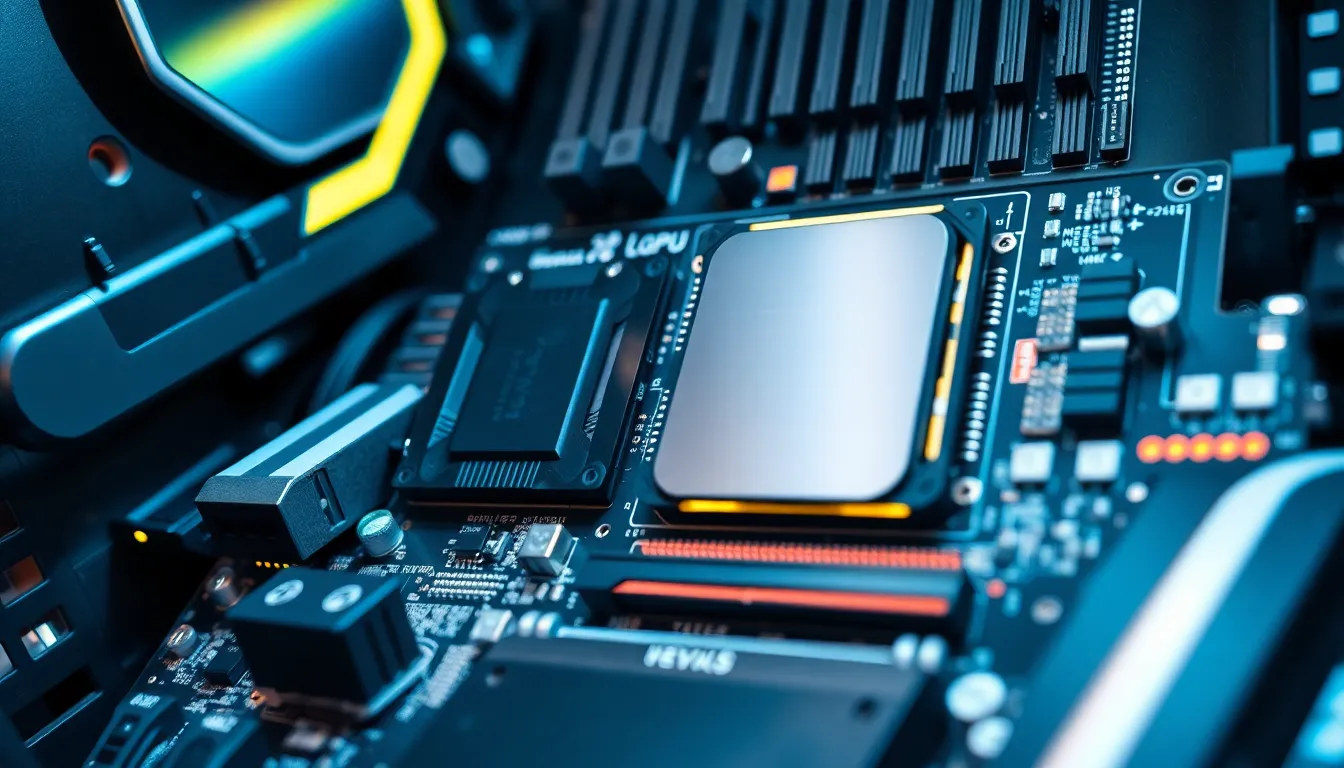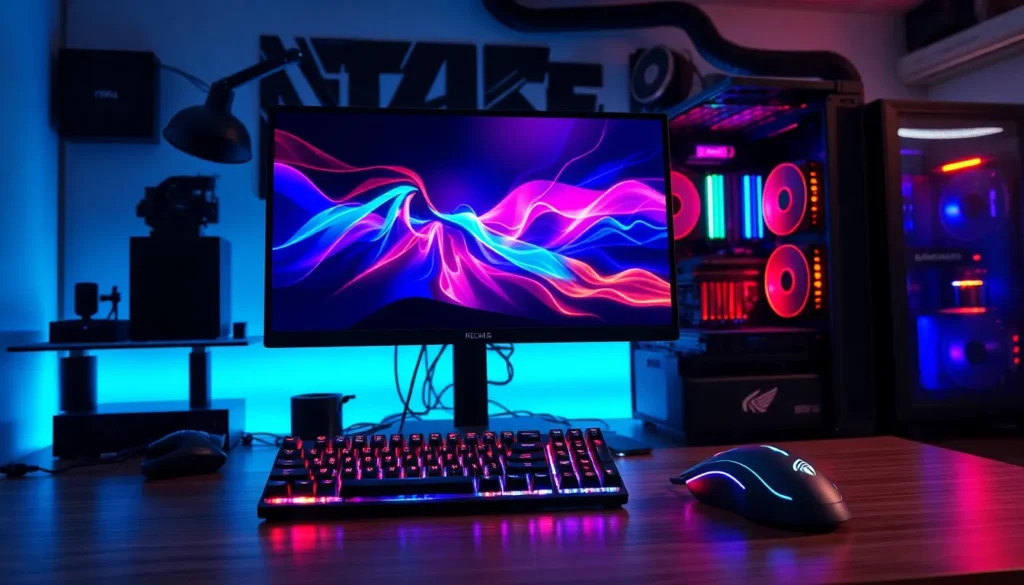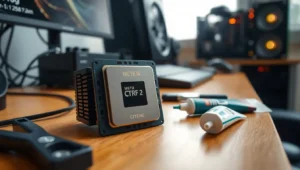In a world where lag can turn a superhero into a snail, high-performance hardware is the unsung hero of tech enthusiasts. Whether it’s gaming, video editing, or crunching numbers, having the right gear can make all the difference between a smooth experience and a digital disaster. Picture this: a powerful GPU that can render graphics faster than you can say “pixelated nightmare.”
Table of Contents
ToggleOverview of High-Performance Hardware
High-performance hardware comprises powerful components that elevate computing tasks. Central Processing Units (CPUs) serve as the brain, executing instructions and managing operations. Graphics Processing Units (GPUs) enhance visual rendering, crucial for gaming and graphic-intensive applications. Memory options such as Solid State Drives (SSDs) significantly boost data retrieval speeds compared to traditional Hard Disk Drives (HDDs).
Customizing systems with high-performance components allows users to optimize workloads effectively. Features like multiple cores in CPUs enable efficient multitasking, while advanced cooling systems maintain stability during extended usage. The integration of faster RAM improves data access times, directly impacting the overall speed of applications.
Many enthusiasts prioritize high-refresh-rate monitors for fluid visuals in gaming. High-performance hardware can also streamline video editing workflows, allowing for quicker rendering times and smoother playback. Specialized peripherals, such as mechanical keyboards and high-DPI mice, further enhance user experience, improving response times and accuracy.
Benchmark tests often reveal the advantages of high-performance setups in real-world situations. Specific configurations might include utilizing NVIDIA’s RTX GPUs for real-time ray tracing. Professional workloads benefit from enhanced processing capabilities, making it easier to manage large datasets.
When selecting high-performance hardware, compatibility plays a vital role. Users should ensure that all components work seamlessly together, optimizing functionality. System builders often rely on rigorous research to find the best combinations of parts, ensuring longevity and reliability.
Key Components of High-Performance Hardware

Understanding key components is essential for those interested in high-performance hardware. The following sections clarify these critical elements.
Processors
Processors serve as the brain of a computer, controlling all operations. Central Processing Units (CPUs) excel in handling multiple tasks due to their cores. Modern processors often have at least four cores, significantly enhancing multitasking efficiency. Intel and AMD provide popular options, with newer generations offering increased clock speeds and improved thermal management. Benchmark tests reveal that top-tier CPUs improve performance in demanding applications.
Graphics Processing Units (GPUs)
Graphics Processing Units (GPUs) play a crucial role in rendering images and video. High-performance GPUs, like NVIDIA’s RTX series, enable real-time ray tracing for realistic graphics. A powerful GPU alleviates strain on the CPU during gaming and graphical tasks, ensuring smoother experiences. Many GPUs now support artificial intelligence processing, further enhancing gaming and creative workflows. Users should consider VRAM and clock speeds when selecting a GPU for optimal results.
Memory and Storage Solutions
Memory and storage solutions greatly impact overall system responsiveness. RAM, measured in gigabytes (GB), influences how many applications run simultaneously. High-performance systems typically utilize at least 16 GB of RAM, though 32 GB or more benefits heavy multitasking. Solid State Drives (SSDs) have advantages over traditional Hard Disk Drives (HDDs) by offering faster read and write speeds. This speed facilitates quicker boot times and reduced loading times in applications. For maximum efficiency, combining SSDs for the operating system with larger HDDs for storage maximizes performance.
Benefits of High-Performance Hardware
High-performance hardware delivers numerous advantages that elevate user experience across various applications.
Enhanced Speed and Efficiency
Speed defines high-performance hardware, with CPUs and GPUs designed for rapid processing. These components work in tandem to execute tasks with minimal lag. Solid State Drives (SSDs) provide fast data retrieval, significantly reducing load times in applications and games. Users notice smoother gameplay and quicker file transfers due to advanced storage technology. Accessing large files or complex datasets becomes effortless, boosting overall system responsiveness. High-performance configurations maximize available bandwidth, ensuring efficient multitasking and seamless user experiences. Eliminating bottlenecks in performance leads to quicker task completion, benefiting both recreational and professional users.
Improved Productivity
Productivity thrives with high-performance hardware due to enhanced system capabilities. Users experience fewer interruptions, resulting in more focused workflows. Multiple CPU cores enable efficient multitasking, streamlining processes for professionals in fields like video editing and programming. High-refresh-rate monitors contribute to detailed visuals, improving the accuracy of tasks performed. Incorporating specialized peripherals, such as mechanical keyboards and high-DPI mice, enhances precision and comfort in daily use. Advanced cooling systems maintain optimal performance during intense workloads, ensuring longevity and reliability. The cumulative effect of these components leads to significant productivity gains in various applications.
Use Cases for High-Performance Hardware
High-performance hardware finds applications across various fields, providing significant benefits in gaming, data analysis, and scientific research.
Gaming
Gamers experience enhanced immersion with high-performance hardware. High refresh rate monitors paired with powerful GPUs deliver smooth visuals and reduced lag. Virtual environments become more engaging as frame rates increase, ensuring responsiveness during gameplay. Customizable setups allow users to fine-tune graphics settings for optimal performance. High-performance CPUs complement GPUs by handling complex game mechanics, resulting in seamless interactions. Enthusiasts who prioritize high-quality gaming often opt for dedicated peripherals, including mechanical keyboards and precision mice, to enhance their experience further. Performance benchmarks consistently show that high-end configurations, like those using NVIDIA’s RTX GPUs for real-time ray tracing, significantly outperform standard setups.
Data Analysis
In data analysis, high-performance hardware accelerates processing speeds. Powerful CPUs with multiple cores enable rapid handling of large datasets, enhancing productivity. Analysts benefit from utilizing ample RAM, typically 16 GB or more, which allows for smooth multitasking and efficient data manipulation. Advanced storage solutions like SSDs decrease load times, getting analysts to insights faster. Users conducting complex simulations or leveraging machine learning techniques appreciate the reliability of high-performance setups. Enhanced computational power facilitates running intricate algorithms and visualizations with ease. Results from benchmark tests frequently confirm that high-performance systems outperform standard configurations in data-intensive tasks.
Scientific Research
Scientific research thrives with high-performance hardware, which supports massive data processing needs. Researchers utilize advanced computing systems to run simulations that require significant computational power. High-performance GPUs not only render complex visualizations but also facilitate AI research by handling extensive neural network calculations efficiently. Equipped with robust memory and storage options, groundbreaking experiments become more manageable. Collaboration becomes seamless as researchers share large datasets without delays. Most studies emphasize that optimized hardware configurations build the foundation for innovative discoveries. High-performance setups ultimately speed up the research cycle, enabling scientists to push the boundaries of knowledge.
Conclusion
Investing in high-performance hardware is a game-changer for anyone looking to enhance their computing experience. The right components not only boost speed and efficiency but also ensure seamless multitasking and improved productivity. Whether it’s for gaming, video editing, or data processing, high-performance setups provide the necessary power to tackle demanding tasks effortlessly.
With compatibility and customization at the forefront, users can build systems tailored to their specific needs. This attention to detail leads to longer-lasting and more reliable hardware. Ultimately, embracing high-performance technology paves the way for smoother workflows and richer experiences, making it an essential consideration for tech enthusiasts and professionals alike.





